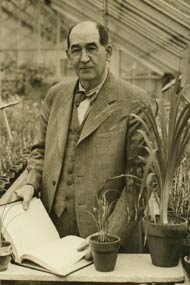
Daylilies are now so widely seen that it may come as a surprise to know that North America has none that are native species – and didn’t arrive in Europe until 16th century travelers and traders brought them there from East Asia (particularly China and Mongolia.) In the 17th century colonists introduced Hemerocallis fulva (known widely as the common daylily or ditch lily) and H. lilioasphodelus (lemon lily, formerly H. flava) and it wasn’t until the last century that cultivars really became available. This was primarily due to the work of Dr. Arlow Burdette Stout (1876-1957).
A. B. Stout grew up in Albion Wisconsin in the late 1800s where he recalled “At that time at least three-fourths of the region about our homes was uncultivated. There was a mosaic of virgin areas of prairie, lowland meadows, swamps and woodlands of several types. There were meandering creeks, larger streams to the size of Rock River and ponds and lake…Plants and animals were diverse and abundant. To me is was a fairyland and almost every spare hour and day in all seasons throughout the hear from the age of 10, I spend afield…I spent much time learning by direct observation as much as possible about the plants, animals (especially birds), rocks, fossils and Indian mounds of the area.” At an even earlier age he was helping in his mother’s vegetable garden, and it was his boyhood observation that her daylilies seldom set seeds that began his life’s work as a scientist and plant breeder.
After a delayed start at college (he’d saved $300 to attend the State Normal School, but the bank which held the deposit failed) he ended up majoring in botany at the University of Wisconsin, where he got his B.A. at age 33 in 1909 and then joined their faculty. In 1911 he was hired by the New York Botanical Gardens where he worked while earning his Ph.D. from Columbia University and continued for 37 years as a geneticist, plant breeder and eventual Curator of Education and Laboratories until his retirement in 1948.
In his first year at the Botanical Gardens Stout began experiments exploring plant sterility and reproductive patterns, including studying self-sterility in daylilies, a characteristic that means a flower cannot become fertilized by its own pollen. He assembled as many varieties as possible, including (through a partnership with Dr. Albert Steward, who taught botany at the University of Nanking and was able to collect plants and seed in remote areas there) a number of previously unknown species which brought many new traits and possibilities for hybridization. Over the years, he made 50,000 crosses between plants and resulting in hundreds of thousands of seedlings to be grown out and evaluated. He was determined to produce varieties that would perform reliably for gardeners, and said of his 1925 seedlings “The best of the flowers are ‘full,’ with broad overlapping petals that are improvements on many of the older types,” exhibiting “in certain hybrids…flowers that are fuller, larger, and more attractive. Increase in the size of the flowers is to be had: some hybrids have flowers nearly twice the size of any of the species or any of the older varieties thus far seen by the writer, and in a few cases, the size is combined with a rare beauty and fullness of flower.” His standards for beautiful color and form were high, and it wasn’t until 1929 that he was satisfied enough to introduce his first named cultivar, ‘Mikado’ along with many of the other nearly 83 splendid varieties that he introduced over his long career. Though he died in 1957, he’d left twelve double varieties which were introduced after his death, with half of the proceeds going to his widow.” (The 1957 catalog for his distributor announced them along with the instructions “Therefore, please supply two checks or money orders in equal amounts when remitting. One to Farr Nursery Company. One to Mrs. Zelda Stout.”) His lifetime of work has provided not only varieties that are still grown and enjoyed today but also the techniques and resources that are used by modern daylily breeders.
When he wrote his own obituary the year before his death Dr. Stout summarized his life’s work in this way: “His main technical research was concerned with experimental studies on the nature and genetics of intraspecific self and cross-incompatibilities in the sexual reproduction of flowering plants.” Though today he is most remembered for his foundational daylily work, of more importance to the Botanical Institute at the time were his agricultural experiments, including his work begun in 1919 to produce seedlessness in grapes, research that he continued through his tenure resulting in scores of new varieties of seedless (and hardier) grapes. In addition, his later research into the pollination patterns of the avocado flower were critical in breeding varieties which fruited reliably and could be grown commercially in orchards and he breeding poplars for pulpwood production. While every word of the obituary Dr. Stout wrote is correct, we also like to recall his more personal description of his life’s work in the final paragraph of his autobiography: “I confess that my efforts in botany throughout a half century as first hobby and then vocation have never seemed to me to be work that is toil or labor.” Since 1950 the American Daylily Society has commemorated him with the annual Stout Silver Medal, the highest award that a daylily cultivar can receive.
Order from the 7 Stout daylilies offered this year: ‘August Pioneer’, ‘Autumn Minaret’, ‘Caballero’, ‘Circe’, ‘Mikado’, ‘Port’ or ‘Theron’. Available for spring or summer delivery.











